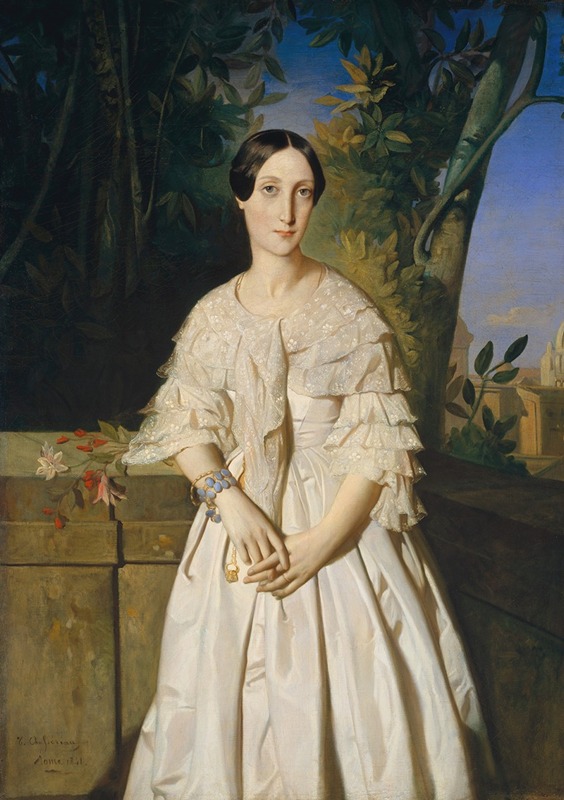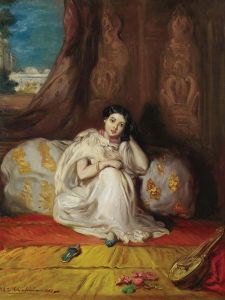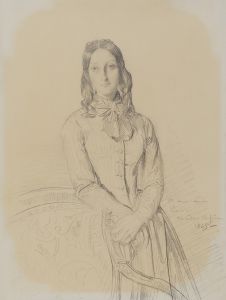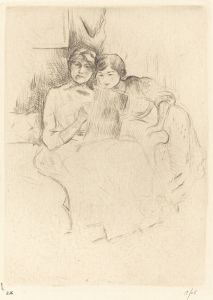
Comtesse de La Tour-Maubourg
A hand-painted replica of Théodore Chassériau’s masterpiece Comtesse de La Tour-Maubourg, meticulously crafted by professional artists to capture the true essence of the original. Each piece is created with museum-quality canvas and rare mineral pigments, carefully painted by experienced artists with delicate brushstrokes and rich, layered colors to perfectly recreate the texture of the original artwork. Unlike machine-printed reproductions, this hand-painted version brings the painting to life, infused with the artist’s emotions and skill in every stroke. Whether for personal collection or home decoration, it instantly elevates the artistic atmosphere of any space.
Théodore Chassériau's "Comtesse de La Tour-Maubourg" is a notable portrait painting created in 1841. Chassériau, a French Romantic painter, is renowned for his portraits, historical and religious scenes, and his ability to blend classical and romantic styles. Born in 1819 in Santo Domingo (now the Dominican Republic), Chassériau moved to Paris at a young age and became a student of the famous painter Jean-Auguste-Dominique Ingres. His work is characterized by its elegance, refined technique, and the emotional depth he brings to his subjects.
The subject of this portrait, the Comtesse de La Tour-Maubourg, was a member of the French aristocracy. Although specific details about her life are not widely documented, her depiction in this painting suggests she was a woman of considerable status and refinement. The portrait captures her in a poised and dignified manner, reflecting the social and cultural milieu of the French upper class during the 19th century.
In "Comtesse de La Tour-Maubourg," Chassériau employs his characteristic style, combining precise, almost neoclassical lines with a romantic sensibility. The Comtesse is depicted seated, her posture elegant and composed. She is dressed in a luxurious gown, indicative of her high social standing, with intricate details that showcase Chassériau's skill in rendering textures and fabrics. The background is relatively simple, ensuring that the viewer's focus remains on the subject.
Chassériau's use of light and shadow in this portrait is particularly noteworthy. The lighting highlights the Comtesse's face and upper body, creating a sense of depth and three-dimensionality. Her expression is serene yet introspective, suggesting a complex inner life. This ability to convey psychological depth is one of Chassériau's strengths as a portraitist.
The painting is also an excellent example of Chassériau's ability to capture the subtleties of human expression and the delicate interplay of light and color. The soft, almost ethereal quality of the Comtesse's skin contrasts with the rich, dark tones of her dress and the background, creating a harmonious and balanced composition.
"Comtesse de La Tour-Maubourg" is housed in the Musée du Louvre in Paris, where it is part of the museum's extensive collection of 19th-century French paintings. The Louvre's collection includes several other works by Chassériau, reflecting his importance in the history of French art.
Théodore Chassériau's legacy as a painter is significant, and his portraits, including "Comtesse de La Tour-Maubourg," continue to be admired for their technical mastery and emotional depth. This painting not only serves as a testament to Chassériau's skill but also provides a glimpse into the world of the French aristocracy during the Romantic period.


















